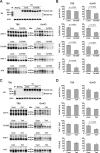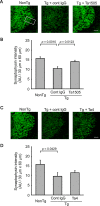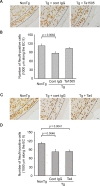Passive immunotherapy of tauopathy targeting pSer413-tau: a pilot study in mice
- PMID: 25815351
- PMCID: PMC4369274
- DOI: 10.1002/acn3.171
Passive immunotherapy of tauopathy targeting pSer413-tau: a pilot study in mice
Abstract
Objective: Cellular inclusions of hyperphosphorylated tau are a hallmark of tauopathies, which are neurodegenerative disorders that include Alzheimer's disease (AD). Active and passive immunization against hyperphosphorylated tau has been shown to attenuate phenotypes in model mice. We developed new monoclonal antibodies to hyperphosphorylated tau and sought high therapeutic efficacy for future clinical use.
Methods: Using more than 20 antibodies, we investigated which sites on tau are phosphorylated early and highly in the tauopathy mouse models tau609 and tau784. These mice display tau hyperphosphorylation, synapse loss, memory impairment at 6 months, and tangle formation and neuronal loss at 15 months. We generated mouse monoclonal antibodies to selected epitopes and examined their effects on memory and tau pathology in aged tau609 and tau784 mice by the Morris water maze and by histological and biochemical analyses.
Results: Immunohistochemical screening revealed that pSer413 is expressed early and highly. Monoclonal antibodies to pSer413 and to pSer396 (control) were generated. These antibodies specifically recognized pathological tau in AD brains but not normal tau in control brains according to Western blots. Representative anti-pSer413 and anti-pSer396 antibodies were injected intraperitoneally into 10-11- or 14-month-old mice once a week at 0.1 or 1 mg/shot 5 times. The anti-pSer413 antibody significantly improved memory, whereas the anti-pSer396 antibodies showed less effect. The cognitive improvement paralleled a reduction in the levels of tau hyperphosphorylation, tau oligomer accumulation, synapse loss, tangle formation, and neuronal loss.
Interpretation: These results indicate that pSer413 is a promising target in the treatment of tauopathy.
Figures








References
-
- Lee VM, Goedert M, Trojanowski JQ. Neurodegenerative tauopathies. Annu Rev Neurosci. 2001;24:1121–1159. - PubMed
-
- Frank S, Clavaguera F, Tolnay M. Tauopathy models and human neuropathology: similarities and differences. Acta Neuropathol. 2008;115:39–53. - PubMed
-
- Umeda T, Yamashita T, Kimura T, et al. Neurodegenerative disorder FTDP-17-related tau intron 10 + 16C → T mutation increases tau exon 10 splicing and causes tauopathy in transgenic mice. Am J Pathol. 2013;183:211–225. - PubMed
LinkOut - more resources
Full Text Sources
Other Literature Sources
Molecular Biology Databases

